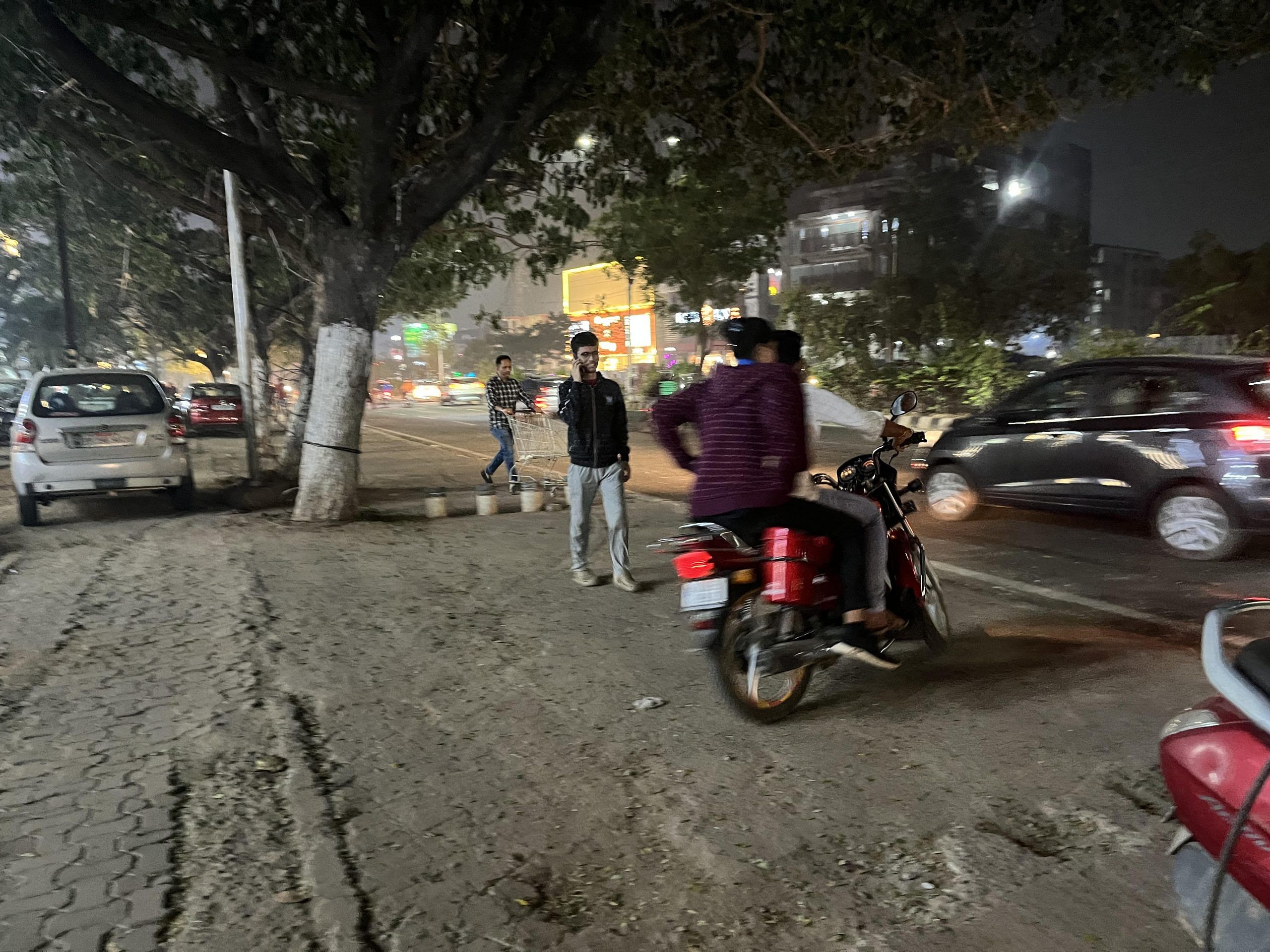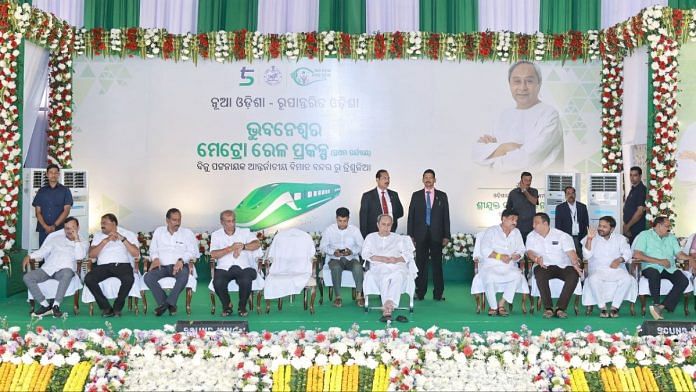Bhubaneswar: It was 7 pm, and Mama Libarik was waiting for her husband to pick her up from Bhubaneswar’s Patia. A saleswoman at Reliance Digital, she scolded him over the phone for not arriving in time for their return journey to Cuttack.
If all goes according to the plan, Mama, 25, and thousands of bread-earners like her can expect travel to become comfortable and faster once the Metro begins operating four years down the line in Bhubaneswar.
A flagship programme under the state’s 5T initiative, the foundation of the Rs 6,225 crore Bhubaneswar Metro Rail project was laid by Odisha Chief Minister Naveen Patnaik on 1 January.
“It will make my life so easy. Now my husband comes to pick me up and we face a lot of traffic too, but I don’t have any other option as I don’t want to travel in buses at night. I am very hopeful about the Metro but it will take some years,” says Libarik, who travels to Bhubaneswar from Cuttack everyday — nearly 30 km one-way — for work.

The ruling Biju Janata Dal (BJD) had mentioned the Metro project in its manifesto for the 2019 general election. With the Lok Sabha and assembly polls now knocking on its doors, the state government has fast-tracked work for the 26-km metro rail link.
“We are being future-ready. We are not doing this to solve a problem, we are doing it to avoid problems for the future. We can’t fall behind as technology is changing the world so fast and we have to be ready for that and the metro is the part of that,” Bhubaneswar Metro Rail Corporation (BMRC) CEO Siba Prasad Samantaray told ThePrint.
In the first phase of the Bhubaneswar Metro project, 22 elevated stations will be built along Line 1 that links Trisulia to Biju Patnaik Airport.
The government has set a four-year deadline to complete Line 1 that has stoppages at Biju Patnaik International Airport (BPIA), Capital Hospital, Sishu Bhawan, Bapuji Nagar, Bhubaneswar Railway Station, Xavier Square, Damana Square, Patia Square, KIIT Square, Nandan Vihar, Raghunathpur, Nandankanan Zoological Park, Phulapokhari, and Trisulia Square.
“This route will cover the most important places of the city like hospitals, education offices, hotels, universities etc. This is a very important corridor compared to other routes and this is the route where people face so much traffic. And our Master plan is to extend the network to Khurda, Puri and Cuttack,” Samantaray said.
The Bhubaneswar Metro Rail Corporation has signed a contract with the Delhi Metro Rail Corporation (DMRC) for the construction. Engineers from the DMRC, who will supervise the work in Bhubaneswar, are set to arrive in March. “DMRC is designing the map. In the initial stage of work, the pillars and girders will be built. We have this office dedicated to the BMRC, where around 60 people of the DMRC will be seated,” added Samantaray.
Bhubaneswar: Favoured destination for homebuyers
Over the past 20 years, Bhubaneswar has steadily seen its skyline change. The Tier-2 city is well-planned for its status as the Odisha capital with huge spaces for greenery. Blessed with good weather, it is home to corporate firms, and medical and educational institutes.
“People are coming from nearby states like Bengal and Jharkhand to live here, because Bhubaneswar offers everything. And with the Metro, this desire will increase,” Bhubaneswar Mayor Sulochana Das told ThePrint.
Das hoped that the project will meet its four-year deadline as there is no underground metro station in the first phase.
The Bhubaneswar Municipal Corporation (BMC) covers an area of 135 sq km (2012) with a population of 8,38,837 (as per the provisional Census, 2011). The population living in BMC limits increased to 0.838 million in 2011 from 0.64 million in 2001 (BMC, 2012) with a compound growth rate of 2.61 percent, according to the Ministry of Urban Development.
The demand for residences and businesses close to the metro line has increased both in Bhubaneswar and Cuttack. The construction of the Bhubaneswar Metro has made the capital city a desirable location for both inhabitants and investors.
“In Bhubaneswar, one has to pay Rs 4 crore for a decent 4 BHK flat in a good society. And people are buying and coming here to settle down,” Das said.
“We have noticed a 50 percent hike in real estate demand. People from Bengal and Andhra Pradesh are coming to Bhubaneswar and Cuttack to settle down. We are seeing many commercial, residential projects like malls, hospitals etc. People are more interested in investing in real estate after the metro project,” Confederation of Real Estate Developers’ Associations of India (Odisha) president Swadesh Kumar Routray said.
Also Read: In Puri, excitement & burgeoning crowds after opening of Jagannath temple’s new heritage corridor
‘Bus service is good so why metro?’
In 2018, the Capital Region Urban Transport (CRUT) had launched Mo Bus operations in Bhubaneswar to encourage commuters to take public transportation instead of using private vehicles, two-wheelers and auto-rickshaws. CRUT was also the first public transport agency to launch its electric buses in Odisha.
The service began with 200 buses and these buses currently operate covering all major locations across Bhubaneswar, Cuttack, Puri and Khordha. The transport service won various awards including United Nations Public Service Awards 2022 and 15th Urban Mobility India Award 2022.
Tophan Behra, 27, drives a cab in Odisha. His brother and wife use the electric bus to travel to Cuttack and Puri for work. “We have very good Mo Sarkar buses in Bhubaneswar. Our population is about 12 lakh. The metro will become a tourist and picnic spot for people, just like the Jaipur Metro,” he said.
Autorickshaw driver Ganesh Sahoo, who has spent all his life in Bhubaneswar and witnessed the city grow in the last 20 years, too, feels the metro project will be wasted as the public transportation is enough for now. “Metro will be wasted here, the government is doing this for the election. Right now there is no need for the metro,” said Sahoo, 45, said.
But the government claims these buses are also under pressure and the number of commuters will only go up with the passage of time.
“We have 305 buses in Bhubaneswar and 100 buses in Rourkela but we can say that they are under high pressure as the daily riders average is around 2.10 lakh,” said Sanjay Biswas, head of urban transport with the Bhubaneswar civic body.
Like any other metro project, viability of the BMRC will be on the top of the minds of the urban planners and policy makers given the large scale of costs involved.
According to a report by IIT-Delhi and Delhi-based think tank The Infravision Foundation, ridership on all metro rail networks across the country is less than 50 percent of their projected ridership.
Barring the Delhi Metro which has a 47.45 percent of its projected ridership, the report says, ridership of most metro rail systems in India is 25-30 percent only
The Odisha government, however, is confident about the success of the metro project in Bhubaneswar.
“Yes there were failed metro projects, but now we have learnt why they failed. We have full confidence that it will be a successful project. We have to make it successful,” said Samantaray. “This is our responsibility that people should feel that the metro is a better option. Infrastructure drives the growth, and we are giving it (the metro) ahead of time.”
Afterall, policymakers feel that a state capital boasting educational institutes like Kalinga Institute of Industrial Technology, IIT-Bhubaneswar, Utkal University and growing rapidly deserves to have a metro system in place.
According to the government, the Metro will decongest traffic and reduce the travel time of people. The metro line commences at Netaji Subhas Chandra Bose Setu, making it easy for people traveling from Cuttack to access key areas of the city without any hassles. Later, the state government plans to extend the metro route to Khurda and the pilgrim town of Puri.
“Right now it takes more than an hour and half to reach Puri from Bhubaneswar. But after the metro is operationalised, this distance could be covered in 30 mins,” Samantray said.
The service is expected to take off with 13 trains and each train will have only 3 coaches, the BMRC CEO said, adding that there will be a 10-minute gap between two trains.
“If the traffic increases and we experience an increase in footfall, then we will reduce the interval time and also put into service more coaches,” Samantray told ThePrint.
(Edited by Tony Rai)
Also Read: Family support, safety, study material a click away — what’s driving more women to take UPSC exam



